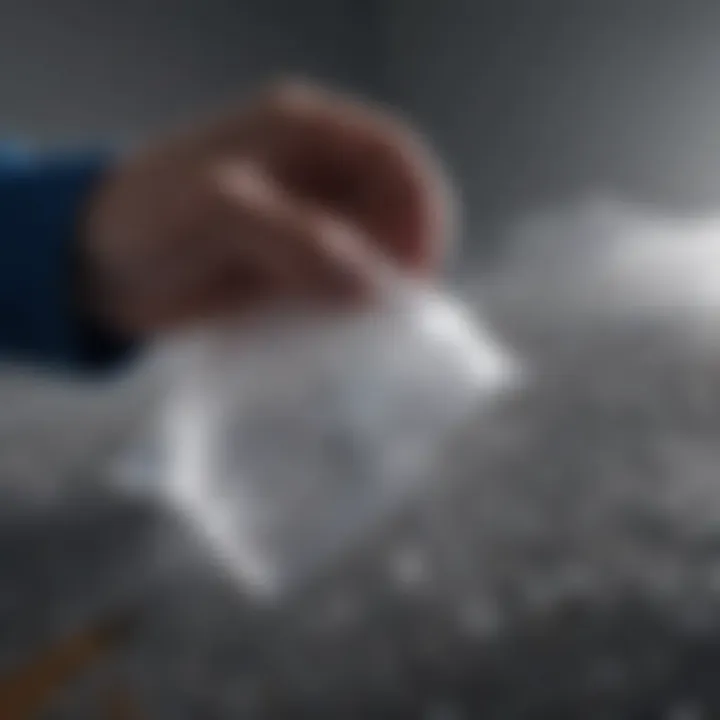Polythene Use: Examining Its Multifaceted Impacts


Intro
Polythene, commonly known as polyethylene, is a versatile polymer that has become integral to numerous sectors, including packaging, construction, and textiles. Understanding its applications and consequences is essential for grasping the complexities of modern materials. This article delves into the myriad impacts of polythene, presenting a balanced view of its benefits and drawbacks.
Article Overview
Purpose of the Article
The main aim of this article is to explore the multifaceted effects of polythene usage. By examining its various applications and the corresponding environmental, health, and regulatory implications, it seeks to foster a well-rounded dialogue on the future of this widely used material. This discussion is particularly pertinent in light of growing awareness around sustainability and environmental conservation.
Relevance to Multiple Disciplines
Polythene's significance stretches across different fields. Environmental science studies the ecological implications of polythene waste. Health sectors investigate its effects on human well-being. Meanwhile, regulatory bodies wrestle with the challenge of managing its use sustainably. All these areas intersect, emphasizing the need for collaborative approaches to mitigate the adverse effects of polythene while leveraging its benefits.
Research Background
Historical Context
Polythene was first synthesized in 1933 and quickly gained popularity due to its durability and utility. Over decades, its applications have expanded dramatically, leading to an increase in its production and use around the world. As industries adopted polythene, concerns about its environmental impact began to surface, especially with the rise of plastic pollution.
Key Concepts and Definitions
To understand the discourse surrounding polythene, it is crucial to define several key terms:
- Polythene: A type of plastic made from the polymerization of ethylene.
- Biodegradability: The ability of a substance to decompose naturally by the action of living organisms.
- Microplastics: Small plastic particles that disrupt ecosystems and can enter the human food chain.
"The ubiquity of polythene in everyday life presents both opportunities and challenges in the search for sustainable solutions."
"The ubiquity of polythene in everyday life presents both opportunities and challenges in the search for sustainable solutions."
Recognizing these definitions will guide readers through the ensuing analysis of polythene's varied impact on society.
Preface to Polythene
Polythene, also known as polyethylene, is a common plastic that serves a myriad of functions in contemporary society. Understanding its significance is essential, as it affects various aspects of everyday life. This section aims to outline both the advantages and challenges related to polythene use.
A primary consideration with polythene is its versatility. It is lightweight, durable, and resistant to moisture, making it suitable for packaging, construction, and many industrial applications. However, its widespread usage has significant consequences, particularly concerning waste and environmental concerns.
Therefore, this article should also take into account the implications of polythene on health and the environment. By evaluating these multifaceted impacts, we can gain insight into possible solutions and a sustainable approach moving forward.
Definition and Composition
Polythene is a type of polymer made from the polymerization of ethylene. Ethylene is a simple hydrocarbon that exists in gaseous form. When subjected to heat and pressure, ethylene molecules join together to form long chains, resulting in polythene. Its molecular structure affects its properties and applications significantly, leading to the existence of different types, each with its unique characteristics.
Types of Polythene
Polythene is categorized into several types based on its density and branching. The main types include Low-Density Polyethylene (LDPE), High-Density Polyethylene (HDPE), and Linear Low-Density Polyethylene (LLDPE). Each type serves distinct purposes, which are critical to understand when discussing polythene's utility and its impacts.
Low-Density Polyethylene (LDPE)
Low-Density Polyethylene, known as LDPE, is characterized by its flexible and lightweight nature. It is often used in applications such as plastic bags, films, and containers. One key characteristic of LDPE is its high resistance to impact, making it a preferred material for various consumer goods packaging. Its unique feature is its ability to stretch without breaking, thus allowing for ease of handling.
However, while LDPE is popular due to its versatility, it has disadvantages. It is not as rigid as HDPE, which limits its use in certain applications. Additionally, LDPE is less environmentally friendly compared to other types, as it lasts long in landfills and is challenging to recycle efficiently.
High-Density Polyethylene (HDPE)
High-Density Polyethylene, or HDPE, is known for its strength and resistance to impact and chemicals. It is commonly utilized in the manufacturing of containers, pipes, and toys. The high density gives it a more rigid structure, making it suitable for varied applications requiring durability. The unique feature of HDPE is its excellent barrier properties, which protect contents from external elements.


On the downside, HDPE's rigidity can limit its use in situations where flexibility is beneficial. Furthermore, while it is easier to recycle than LDPE, issues regarding recycling infrastructure still remain.
Linear Low-Density Polyethylene (LLDPE)
Linear Low-Density Polyethylene, LLDPE, is a relatively newer form of polyethylene. It is created by copolymerizing ethylene with other types of alpha-olefins. One significant aspect of LLDPE is its enhanced strength and flexibility compared to LDPE. This makes it a popular choice for stretch films and heavy-duty bags.
The unique feature of LLDPE is its ability to combine the best properties of both LDPE and HDPE, hence offering excellent handling and puncture resistance. However, similar to its counterparts, LLDPE presents challenges in recycling, highlighting the need for increased awareness and efficient waste management strategies.
Applications of Polythene
The applications of polythene are vast and varied, making it a crucial topic in understanding the material's multifaceted impacts. From everyday consumer products to specialized industrial uses, polythene has enabled innovations and efficiencies across multiple sectors. This section examines three primary applications: consumer goods packaging, industrial applications, and medical use.
Consumer Goods Packaging
Consumer goods packaging stands as one of the most prevalent uses of polythene. The flexibility, durability, and moisture resistance of polythene make it an ideal choice for packaging food, beverages, and other household items. It enhances product shelf life, ensuring that items remain fresh and protected from environmental factors.
Moreover, the lightweight nature of polythene reduces transportation costs and energy consumption, beneficial in an era where sustainability is increasingly important. Common forms of consumer packaging include plastic bags, shrink wraps, and bubble wraps. The widespread adoption of polythene has revolutionized the packaging industry but not without consequences. Excessive use has contributed to the global plastic waste crisis, necessitating the exploration of more sustainable alternatives.
Industrial Applications
Beyond consumer goods, polythene plays a vital role in various industrial applications. Its properties allow for its use in manufacturing, construction, and agriculture. In manufacturing, polythene is often utilized for creating components, machinery parts, and conveyor belts due to its resistant qualities and lightweight nature. In construction, it serves as a barrier against moisture, preventing damage to buildings and enhancing their longevity.
In agriculture, polythene sheets are employed for mulching, helping to control weeds and retain soil moisture. This method not only increases crop yields but also reduces the need for chemical herbicides, proving beneficial for the environment. Industrial applications of polythene illustrate its versatility; however, the long-term effects on waste management and environmental sustainability are pressing concerns that demand careful consideration.
Medical Use
Polythene's role in the medical field is significant and often critical. Its use in the production of medical devices, packaging, and disposable items such as gloves and syringes highlights its importance. Polythene is resistant to moisture and many chemicals, thus ensuring sterility and safety in healthcare settings. The lightweight quality also aids in the transportation of medical supplies.
The growth of telemedicine and home healthcare has further increased the demand for polythene products. However, the disposal of single-use medical plastics poses a challenge. It not only generates substantial waste but also raises concerns about environmental health. Thus, there is an urgency to explore biocompatible and biodegradable materials to replace traditional polythene in medical use.
Polythene applications demonstrate the material’s utility across different sectors, yet also emphasize the need for advances in sustainability.
Polythene applications demonstrate the material’s utility across different sectors, yet also emphasize the need for advances in sustainability.
The applications of polythene emphasize its significance while simultaneously highlighting critical challenges. Each area discussed—the consumer packaging, industrial use, and medical field—reveals a complex web of benefits and environmental considerations that must be addressed as society moves forward.
Environmental Concerns
The significance of Environmental Concerns in the context of polythene use cannot be overstated. Polythene, a widely utilized plastic, has impressive characteristics, offering durability and versatility. However, its extensive use leads to multiple environmental challenges that warrant in-depth exploration. Understanding these issues is vital for improving sustainable practices and seeking viable alternatives.
Pollution and Waste Management
Polythene contributes extensively to pollution, particularly in urban settings. The improper disposal of polythene products leads to the accumulation of waste in landfills and the environment. Recycling rates for polythene are often low, resulting in substantial waste. Many countries struggle to manage polythene waste effectively, causing land and marine litter.
- Challenges in Recycling: Unlike some other plastics, polythene is often not accepted in curbside recycling programs. This limitation leads to fewer effective recycling options. Many polythene products end up in landfills or incinerators, exacerbating waste management challenges.
- Littering Affects: Visible waste can hinder natural beauty and affect biodiversity. Furthermore, the litter can disrupt drainage systems, increasing flood risks.
Addressing these issues requires policy change and public education to improve waste management practices.
Impact on Marine Life
One of the most pressing concerns associated with polythene is its impact on marine life. Discarded polythene products often travel from land to the ocean, posing lethal threats to aquatic ecosystems.
- Ingestion Hazards: Marine animals can mistake polythene bags for food. This ingestion can lead to malnutrition and internal injuries, which can ultimately result in death.
- Entanglement Risks: Larger polythene items can entangle marine creatures, impairing their ability to swim and hunt. Such entanglements can lead to severe injury or death.
Studies suggest that over 800 species are affected by marine debris, primarily polythene. Protecting marine biodiversity is crucial, and meaningful steps must be taken to reduce polythene waste in oceans.
Microplastics and Their Effects
Microplastics are tiny plastic particles that originate from the degradation of larger plastic products, including polythene. These particles pose significant environmental and health risks.


- Sources of Microplastics: They can originate from various products, including cosmetics and clothing, but polythene waste contributes to a large share of these particles in the environment.
- Ecosystem Contamination: Microplastics can accumulate in soil, air, and water. Many aquatic organisms ingest these particles, affecting their health and entering the food chain.
Research has not fully concluded the long-term effects of microplastics on human health. Yet, their presence raises meaningful questions about the safety of consuming seafood, where contamination may occur.
"To mitigate the effects of polythene, it is essential to foster changes in consumer habits as well as significant policy measures."
"To mitigate the effects of polythene, it is essential to foster changes in consumer habits as well as significant policy measures."
Health Implications of Polythene
The health implications of polythene are significant and require thorough exploration. It is not simply a matter of convenience; the very materials that make life easier can pose various health risks. Understanding these implications is essential. Notably, polythene can leach chemicals, which is crucial for consumers and health professionals. The usage of polythene is widespread, and so are its potential hazards. Evaluating chemical interactions and long-term exposure is necessary for public awareness and safety.
Chemical Leaching
Chemical leaching from polythene products is a substantial concern. This process occurs when certain substances migrate from the polythene into food or drinks. In some cases, compounds such as plasticizers, antioxidants, and stabilizers can leach into consumables. These substances are often added to enhance flexibility or durability.
Research observes that the effects of chemical leaching can vary under different conditions like heat, UV exposure, or the type of food. For instance, acidic or fatty foods can increase the rate of leaching. A common example is the migration of bisphenol A (BPA), which is associated with several health risks, including hormonal disruptions.
Additionally, it is crucial to recognize that the long-term consumption of chemicals from polythene could accumulate in the human body, potentially leading to unknown health effects. Awareness is key for making informed decisions about the use of polythene products.
"Consumer safety often hinges on awareness and understanding of materials used in everyday products."
"Consumer safety often hinges on awareness and understanding of materials used in everyday products."
Human Health Risks
The human health risks associated with polythene are multifaceted. Concerns range from mild allergic reactions to severe long-term health conditions. Exposure to harmful substances leached from polythene can impact immune systems, reproductive health, and even cognitive functions.
Some potential human health risks include:
- Endocrine Disruption: Certain chemicals from polythene can mimic hormones, distorting endocrine functions.
- Allergic Reactions: Some individuals may experience skin irritations or allergies when using products containing polythene.
- Respiratory Issues: Inhalation of fine particles from polythene, especially during the burning process, can cause respiratory problems.
A comprehensive review of existing literature suggests that repeated and prolonged exposure could present both short-term and chronic health issues. Further research is required to create a more complete understanding of these risks and to establish better safety standards concerning polythene use.
Overall, health implications underscore the importance of scrutinizing polythene products. As consumers, being informed can lead to better choices and potentially safer alternatives in the future.
Regulatory Framework
The regulatory framework surrounding polythene is essential for managing its usage and addressing the multifaceted impacts. Governments, organizations, and communities must work together to create laws and guidelines aimed at reducing environmental harm while balancing economic benefits. These regulations focus on various elements, such as the production, circulation, and disposal of polythene, significantly influencing its overall impact on society. The benefits of an effective regulatory framework include promoting waste management practices, reducing pollution levels, and encouraging innovation in sustainable materials.
International Regulations
At the international level, various agreements and treaties aim to address global environmental issues associated with polythene. The Basel Convention, for example, regulates the transboundary movement of hazardous wastes and aims to reduce the generation of hazardous waste, including specific plastic waste. Similarly, the United Nations Environment Programme (UNEP) has started initiatives focusing on plastic pollution, guiding countries to develop appropriate measures to curb this growing concern. Such initiatives encourage collaboration between nations to diminish plastic use and develop alternatives while ensuring economic growth.
National Policies
In many countries, national policies have been established to control polythene usage. These policies often include bans on single-use plastic items, which directly impacts the consumption of polythene products. For instance, countries like Canada and France have implemented comprehensive strategies that promote biodegradable alternatives. National policies also facilitate public awareness campaigns aimed at educating citizens about the importance of reducing, reusing, and recycling plastics. Such frameworks aim to diminish reliance on polythene and foster more sustainable practices.
Local Initiatives
Local initiatives can be quite impactful, as they involve communities in the conversation about polythene usage. Local governments often create policies suited to their specific needs. This can include regulations on plastic bag usage or incentivizing businesses to reduce plastic packaging. For instance, many cities have adopted 'plastic-free initiatives' that promote local markets to offer alternatives, such as reusable bags and containers. Engaging local communities helps to foster a collective sense of responsibility towards reducing polythene consumption.
"Local actions can drive significant change when communities engage in sustainable practices."
"Local actions can drive significant change when communities engage in sustainable practices."
Sustainable Alternatives to Polythene


The significance of identifying sustainable alternatives to polythene lies in the urgent need to mitigate its adverse environmental impacts. As awareness of plastic pollution grows, society seeks solutions that can minimize reliance on traditional plastics. Sustainable alternatives not only help in reducing waste but also provide practical, functional substitutes in various applications. They encompass a broad spectrum of materials, including biodegradable plastics, reusable materials, and innovations in material science. This section will discuss these alternatives, highlighting their benefits and considerations.
Biodegradable Plastics
Biodegradable plastics offer a promising approach for reducing the ecological footprint associated with polythene. Unlike conventional plastics, which can take decades to decompose, biodegradable options are designed to break down more quickly, particularly when exposed to environmental factors such as moisture and microorganisms. The main materials used in biodegradable plastics include starch-based polymers and polylactic acid (PLA).
While biodegradable plastics present benefits, there are considerations to take into account. They require specific conditions to degrade properly, such as industrial composting facilities, which may not be available in all regions. Furthermore, some biodegradable plastics still release microplastics upon degradation. Therefore, an assessment of local waste management systems is necessary to ensure that their adoption is effective.
Reusable Materials
Reusable materials represent a crucial aspect of reducing reliance on single-use polythene products. Products made from glass, metal, or durable fabrics can significantly lower the environmental burden. For example, stainless steel bottles and glass containers can replace plastic food storage options. The circular economy model emphasizes reusing materials, thereby extending their lifecycle and reducing overall waste.
Transitioning to reusable materials involves societal changes in consumer habits and preferences. Education about the benefits and practicalities of reusability is essential in driving this shift. In addition, policymakers can incentivize manufacturers to produce more reusable options through subsidies or tax breaks.
Innovations in Material Science
Material science continues to evolve, presenting innovative solutions that could potentially replace polythene. Researchers are exploring novel materials that possess similar or superior characteristics to traditional plastics but with reduced environmental impact. For instance, innovations like mushroom-based packaging and seaweed-derived bioplastics are paving the way for a sustainable future.
These advancements may possess unique properties such as being compostable or offering better barrier protection against moisture. As investments in research intensify, the development of these materials could lead to scalable solutions that meet industry demands. Collaboration between academia, government, and industry stakeholders is critical in facilitating this research, ensuring that sustainable innovations can reach the market effectively.
"Sustainable alternatives to polythene are not just desirable; they are essential for a healthy planet."
"Sustainable alternatives to polythene are not just desirable; they are essential for a healthy planet."
Future Directions in Polythene Use
The exploration of future directions in polythene use is paramount in the current climate of environmental urgency. Understanding how polythene evolves can dictate its role within our economy and society. This section will address emerging research innovations and the necessity of public perception and education, shedding light on vital considerations for sustainable practices.
Research Innovations
Recent advancements in material science are paving the way for innovative approaches to polythene. Researchers are actively seeking ways to enhance the sustainability of polythene applications. A few promising developments include:
- Recycling Techniques: New methods for chemical recycling enable the breakdown of polythene into its monomers, allowing for re polymerization, creating a closed-loop system. This reduces the need for virgin materials and minimizes waste.
- Bioplastics: The emergence of bioplastics, derived from renewable resources, provides alternatives that mimic the properties of conventional polythene. Innovations in this area focus on improving their durability to meet industry standards.
- Life Cycle Assessments (LCA): Researchers are conducting LCAs to better quantify the environmental impact of polythene from production to disposal. This data informs more eco-friendly decision-making in polythene use and guides regulatory policies.
These innovations possess the potential to positively reshape polythene's perception. Positive advancements signal not just a response to environmental challenges, but also underscore an evolving industry that embraces sustainability.
Public Perception and Education
Public perception of polythene will play a crucial role in its future. Increased awareness about environmental issues has triggered changes in how consumers view this material. Education can empower individuals with the knowledge to make informed choices. Strategies may include:
- Awareness Campaigns: Highlighting the environmental impact of polythene and presenting sustainable alternatives. Campaigns can inform people about proper disposal methods and recycling options.
- Incorporating Sustainability into Education: Educators can integrate polythene-related case studies into curricula, encouraging students to explore the material's complexities and sustainability challenges.
- Engagement with Stakeholders: Collaborations between governments, businesses, and communities to address misconceptions related to polythene. Open dialogue can promote shared responsibilities and collective action.
"Public engagement is a powerful tool for change. When people understand the implications of their choices regarding polythene, they can drive demand for better practices and alternatives."
"Public engagement is a powerful tool for change. When people understand the implications of their choices regarding polythene, they can drive demand for better practices and alternatives."
In summary, the future of polythene hinges significantly on research and the role of public perception. As we advance, embracing sustainable innovations and valuing educational initiatives will foster a more responsible approach. This can lead to improved practices and perceptions surrounding polythene, shaping a more sustainable future.
Culmination
The exploration of polythene's multifaceted impacts underscores the need for meticulous consideration of its role within contemporary society. As discussed, polythene presents a range of applications, from packaging to medical use, which make it undeniably useful. However, this comes with consequential environmental and health concerns that cannot be overlooked. This duality of benefits and drawbacks highlights the significance of evaluating polythene's overall impact.
Summary of Key Points
In summary, this article has revealed critical insights into the multifaceted nature of polythene. Key takeaways include:
- Versatility: Polythene is widely used across consumer goods, in industrial contexts, and for medical purposes, demonstrating its adaptability.
- Environmental Implications: Issues surrounding pollution, microplastics, and their impact on marine life highlight the urgent need for better waste management strategies.
- Health Risks: The potential for chemical leaching into food items presents real concerns for public health.
- Regulatory Framework: Various international and local regulations are established to curb negative impacts, but compliance and enforcement vary significantly.
- Sustainable Alternatives: There are emerging innovations in sustainable materials that could offer environmentally friendly substitutes for polythene, indicating a pathway toward better practices.
Call for Action
Given the extensive implications associated with polythene use, it is imperative for stakeholders at all levels — from manufacturers to consumers — to embrace sustainable practices. Critical actions include:
- Advocating for Regulation: Support consistent and robust regulations that limit polythene use and encourage the adoption of sustainable alternatives.
- Promoting Research: Invest in research on biodegradable materials and effective recycling methods to mitigate environmental damage.
- Raising Awareness: Educate the public on the risks and practices surrounding polythene to encourage more informed consumption choices.
By taking these steps, all parties can contribute to minimizing the negative aspects of polythene while maximizing its utility in a responsible manner. Only through collective efforts can we hope to navigate the challenges posed by polythene in a sustainable way.



